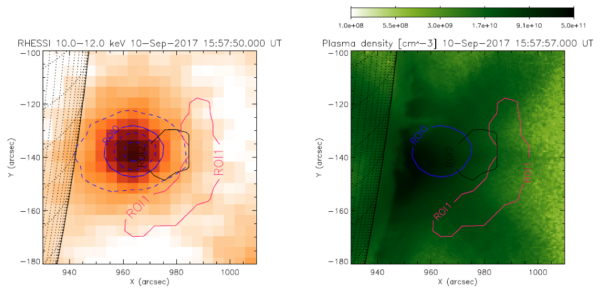Did a Solar Flare Accelerate all the Ambient Electrons in the Coronal Acceleration Region?...
| Nugget | |
|---|---|
| Number: | 449 |
| 1st Author: | Gordon EMSLIE |
| 2nd Author: | et al. |
| Published: | May 1, 2023 |
| Next Nugget: | TBD |
| Previous Nugget: | Diagnostics of Spatially-Extended Turbulent Acceleration and Transport |
Introduction
It is well-known that solar flares accelerate large numbers of electrons, as evidenced by the copious hard X-ray bremsstrahlung that they produce (and which RHESSI was designed to observe and characterize). But just how efficient is the acceleration mechanism, as measured by the fractional number of accelerated electrons? In this Nugget, we report on RHESSI observations of hard X-ray emission in the well-observed flare SOL2017-09-10, combined with EUV images from the SDO/AIA instrument and GHz radio emission from EOVSA. While the radio observations suggest that a very large fraction of the available coronal electron population (around 100%) gets promptly accelerated to energies above 20 keV, leaving very few electrons in the thermal background, the hard X-ray observations tell a different story, (Ref. [1]), with at best a few percent of the electrons accelerated to the energies required to produce the observed hard X-ray emission.
An unexpected finding
The canonical picture for electron acceleration in a flare is as follows: in a coronal region with density nth equal to a few times 1010 cm-3 (corresponding to an emission measure EM = nth2V of about 1048 cm-3, consistent with soft X-ray observations), an electric field of order the "Dreicer field" (about 0.4 mV/cm) accelerates one to ten percent of the electrons in the high-energy tail of the distribution, resulting in a nonthermal electron density of about 109 cm-3. This is equivalent to an acceleration rate N = n A v, or about 1037 particles/s , consistent with the electron acceleration rate deduced from hard X-ray observations. However, this rather tidy, self-consistent, picture has recently been brought into question by EOVSA radio observations (Ref. [2]) of the GOES X8.2 flare SOL2017-09-10.

The left and center panels of Figure 1 show, respectively, maps of the thermal and nonthermal electron number densities deduced from the EOVSA observations alone. A large banana-shaped region (called Region of Interest 1 or ROI-1) is evident, in which the number density of thermal electrons is very low (less than 107 cm-3), while the number density of nonthermal electrons is much higher (more than 109 cm-3). To explain these observations, Ref. [2] suggests that a rapid change in the magnetic field of about 5 G/s occurs during the assumed magnetic reconnection process, and that this occurs over an extended distance of 5 arc seconds (or 4 x 108 cm) (Ref. [3]). Faraday's law then implies a very large electric field of about 20 V/cm, five orders of magnitude larger than the Dreicer field. This highly super-Dreicer electric field effectively accelerates all of the ambient electrons, which reach hard X-ray-producing energies over a distance of about 10 m, taking only a tenth of a microsecond to do so!
A riddle wrapped in a mystery inside an enigma
The above quote, made by Winston Churchill in 1939 about the projected role of the Soviet Union in WW II, is very appropriate in the present context, because RHESSI observations obtained at the same time (left panel of Figure 2) show that most of the hard X-rays come not from ROI-1, but rather from the much lower ROI-0 region. Also, thin-target hard X-ray emission from a region is straightforwardly proportional to the product of the nonthermal and thermal electron densities, and using the values obtained by Ref. [2] results in a hard X-ray map that is not at all consistent with that observed by RHESSI (right panel of Figure 1). Adding to the mystery, density maps obtained from reconstructions of the EUV differential emission measure using SDO/AIA data (right panel of Figure 2) show a thermal density in ROI-1 that is more like 109 cm-3. Combined, these observations point to a ratio of the nonthermal to thermal electron densities that is about 0.01, far short of the claim in Ref. [2] that "all" of the electrons are accelerated.

Solving the riddle
The dramatically different values for the nonthermal/thermal ratio, from about 0.01 (combined RHESSI hard X-ray and SDO/AIA EUV observations) to unity (EOVSA radio observations), present us with a dilemma: how can we reconcile such apparently disparate results? It should be noted that radio observations are much more sensitive to electrons with rather high energies > 100 keV, and that estimating the number of electrons accelerated above, say, 20 keV, from such data requires spectral extrapolation. The spectrum used in Ref. [2] for this purpose was rather steep (power-law index of 5-6), somewhat steeper than the spectral index of about 3 determined from RHESSI hard X-ray observations. A flattening of the electron spectrum at lower energies would reduce the non-thermal number by a significant factor, bringing it more in line with the value deduced from RHESSI observations. Given EOVSA has angular resolution of about 20 arc sec at 5 GHz, imaging spectroscopy using an area larger than the 2 arcsec pixels used in Refs. [2,3] could improve the large radio flux uncertainties at higher frequencies and contribute to the resolution of the dilemma. Further observations, such as from the forthcoming Square Kilometer Array, would be very helpful in constraining the electron spectrum deduced from radio observations.
Acknowledgements
The co-authors of Ref. [1] (and of this Nugget) are Eduard Kontar, Gordon Emslie, Galina Motorina, and Brian Dennis
References
[1] "The efficiency of electron acceleration during the impulsive phase of a solar flare"
[2] "Solar flare accelerates nearly all electrons in a large coronal volume"
[3] "Decay of the coronal magnetic field can release sufficient energy to power a solar flare"